ANGELS (Argos Neo on a Generic Economical and Light Satellite)
Non-EO
USAF
Communications
Quick facts
Overview
| Mission type | Non-EO |
| Agency | USAF |
| Launch date | 18 Dec 2019 |
ANGELS (Argos Neo on a Generic Economical and Light Satellite)
Spacecraft Launch Mission Status Ground Segment References
Argos is the only global satellite-based system for location and data collection designed specifically to study and protect our planet’s environment. Governed via an international collaboration between the major international space agencies, including NASA, NOAA, CNES, EUMETSAT and ISRO, the Argos constellation includes 6 operational satellites that cover the globe in near-real time, providing satellite telemetry services to over 22,000 active user platforms [PTTs (Platform Transmitter Terminals)] every month.
The Argos constellation’s future is secure until at least 2040, with Argos DCS (Data Collection System) instruments built by CNES scheduled to be onboard the Metop Second Generation satellites (starting in 2022). In addition, CNES is launching an innovative new project, Argos ANGELS (Argos NEO Generic Economic Light Satellites), involving the development of a new miniaturized Argos instrument, Argos NEO, developed by TAS (Thales Alenia Space) in collaboration with Syrlinks, that will fly on board a miniaturized platform, the first French nanosat, built by Nexeya in collaboration with CNES. 1) 2) 3) 4)
The ANGELS nanosatellite is being designed and built by NEXEYA of Toulouse, France.
The Argos ANGELS satellite is planned to launch in 2019 and will serve as a prototype for a new Argos constellation, mixing satellite telemetry and spaceborne IoT, starting in 2022.
Project organization and partners 5)
• CNES provides program management, launch procurement, in flight operations, active support to the industry during the development phase.
• CLS (Collecte Localisation Satellites), a CNES subsidiary with HQ in Toulouse, France, provides Argos mission operations. The ANGELS MOC (Mission Control Center) is allocated in CLS, common to other Argos instruments.
• NEXEYA is the prime contractor, covering the satellite and the ground control segment
- Payload delivered by CNES (instrument developed by TAS & Syrlinks)
- 7 subcontractors and more than 12 main suppliers
- In-house: structure, harness, OBSW (OnBoard Software), MLI (Multi-Layered Insulation).
This project, launched in May 2017, aims to develop and commercialize a range of satellites with a mass of <50 kg, particularly suited to radiofrequency-type operational missions such as data collection (ARGOS, AIS, M2M) or the monitoring of satellites. CNES plays the card of disruptive innovation, both at the technical level and at the level of governance - bringing in its expertise to the industrial consortium with a team of engineers with solid experience in space, integrated into a project platform at NEXEYA. It brings together the best players in the sector in the framework of innovative and balanced cooperation by providing its skills and expertise to industrial entrepreneurs. In parallel, the miniaturization of the ARGOS-NEO payload by Syrlinks and TAS is progressing in the same spirit of innovation in all areas of this development.
All energies are focused to keep the schedule extremely ambitious and to be at the rendezvous of the launch in Q4 2019. In this sense, the first electronic chart engineering models are already available and the detailed design review will be held in early 2018. Widely collaborative for NEXEYA, the ANGELS project brings together many industrial partners such as CS, Erems, Mecano-ID, SAFT, Spacebell and Steel. It also federates multiple talents and faces multiple challenges such as the maintenance of equipment radiation, the control of disturbing electromagnetic emissions or even the development schedule particularly short. This key step has now been successfully completed, the marketing of the Smallsat range will begin which will allow the French space industry to take its full place in NewSpace.
Spacecraft
ANGELS is a nanosatellite demonstrator program pursuing several objectives:
• Open the path in France to a different way to manage, design and build a space program
• Perform an in-orbit demonstration of a miniaturized ARGOS instrument (ARGOS Neo project), as a precursor of miniaturized payload in the domain of data collect and IoT missions
• Develop a 12U nanosatellite, as a precursor of a future industrial nanosatellites product line in the range 10-50 kg to be able to enter the small satellite market for in orbit operational missions.
HEMERIA has been selected by the CNES as prime contractor for ANGELS. They are responsible for the delivery of the nanosatellite demonstrator with its associated ground segment.
The ANGELS project is co-funded by CNES and
- HEMERIA and some of its partners for the satellite and the ground control segment,
- Thales Alenia Space for the payload, which is developed jointly with Syrlinks.
The first application platform shall be coupled with the miniaturized ARGOS payload: The ANGELS satellite objectives shall be, beyond the ARGOS mission: 6)
• Be a precursor of an industrial business line of nanosatellite platforms
• Prefigure the next generation of data collection payloads
• In orbit validation of new technologies (COTS, ....)
• Validate new project management methods together with SMEs.
The Nexeya system design is based on a 12U CubeSat . The ANGELS demonstration mission is expected with a life of 2 years in flight operations.

Data handling:
• Support for numerous protocols, up to 200 Mbit/s
• Software architecture based on TSP (Trusted System Platform)
• AOCS (Attitude and Orbit Control Subsystem): Simple and robust AOCS for reliable attitude control (<5º precision) compatible with any SSO (Sun Synchronous Orbit) LTAN (Local Time on Ascending Node)
• S-band CCSDS communication (16 kbit/s, 400 kbit/s) with the satellite
• Stringent EMC (Electromagnetic Compatibility) management control.
Power architecture:
• 96 W of installed solar power and a modular architecture to handle up to 250 W
• Distributed unregulated VBAT (battery), regulated and protected, 5V and 3V3
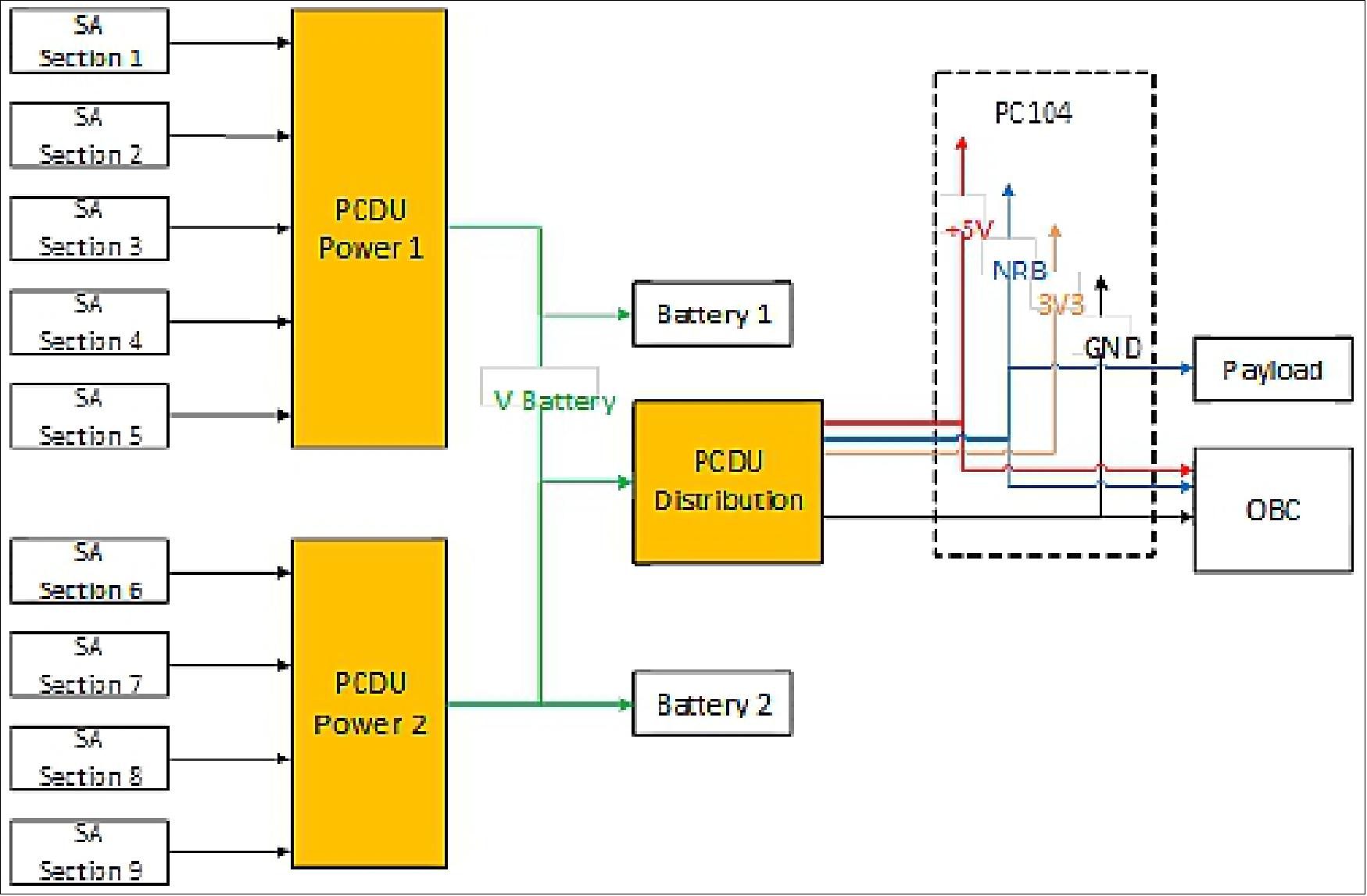
Development status
• April 2019: Twenty years after its creation, board members of French industrial group Nexeya have agreed to spin-off its space and satellite business in the third quarter of 2019 and name it Hemeria, according to a press release dated 12 April 2019. 8)
- The transfer of the Nexeya group’s space activities into the new Hemeria company will allow it to focus its development efforts on the strong growth opportunities offered by the New Space sector in Europe and around the world.
- Additionally, the Nexeya board accepted a proposed acquisition of the company’s non-space activities by the European group Hensoldt.
- These corporate developments are subject to various French government and EU authorizations as well as to the ongoing information consultation procedure of the Institutions for Occupational Retirement Provisions (IORP) dealing with company pension plans, and should be completed by the beginning of the third quarter of 2019.
- Hemeria, wholly owned by Nexeya Group’s holding company, will consolidate all of the company’s space activities, including satellite equipment and nanosatellite manufacturing, as well as certain sovereign defence activities related to French national security. These activities currently represent a turnover of around €36 million and a staff of about 200 people.
• December 13, 2018: CNES and NEXEYA, who are co-funding and developing ANGELS (Argos Neo on a Generic Economical and Light Satellite), the first series-produced French nanosatellite, have reached a new milestone with the Detailed Design Review (DDR) of the satellite and anechoic chamber testing of its engineering model. The design is now frozen and flight models of systems are in production for the start of satellite integration and testing in May 2019. 9)
- The excellent test results have firmed up the development plan and CNES and NEXEYA have therefore decided to accept Arianespace’s offer to launch the satellite in Q4 2019 from the Guiana Space Centre (CSG).
• September 10, 2018: With the support of CNES, CLS (Collecte Localisation Satellites) is proud to announce the creation of a new subsidiary: KINEIS. By 2030, Kineis plans to connect several million objects around the globe, becoming a leader in the new space race. New Space companies and the general public alike will have access to a global satellite location and connectivity service that is both easy to use and very affordable. This connectivity is being offered by an unprecedented constellation of nanosatellites developed with: Thales Alenia Space, Nexeya and Syrlinks. The constellation will be in orbit by 2021. 10)
- With connected watches, cars and now even houses, the time has come for the IoT (Internet of Things) revolution. According to a study published by CISCO, by 2020 there will be more than 30 billion connected objects in the world. This unprecedented development will transform the world economy. Currently, 90% of the world is either not network-connected, or connected but prohibitively expensive. Furthermore, today’s IoT offer is difficult to use. Yet the needs exist now: how do you find a lost container? Or a container is transporting perishable goods: how do you remotely control its temperature? A traditional fishing boat suffers engine failure: how do you send out an SOS call? How do you track it down to offer assistance? A hiker in Nepal wants to share his trip with his friends and family in real time: how can he post his route? Logistics, fishing, agriculture and outdoor recreation are all sectors seeking affordable global connectivity!
• May 18, 2017: Thales Alenia Space will supply the Argos Neo instrument for the nanosatellite demonstrator ANGELS (Argos Neo on a Generic Economical and Light Satellite). The satellite for this French space agency CNES mission is being built by Nexeya. 11)
- According to Philippe Blatt VP Navigation at Thales Alenia Space, “This solution, supported by a consortium that is fully engaged in advanced technologies and the associated products, is intended as a bridge between the past and future of the Argos system, as well as reflecting French excellence in data collection via satellite. Thales Alenia Space is very proud to be a key player in this impressive program.”
• March 8, 2017: Argos is the only global satellite-based system for location and data collection designed specifically to study and protect our planet’s environment. Governed via an international collaboration between the major international space agencies, including NASA, NOAA, CNES, EUMETSAT and ISRO, the Argos constellation includes 6 operational satellites that cover the globe in near-real time, providing satellite telemetry services to over 22,000 active user platforms [PTTs (Platform Transmitter Terminals)] every month. 12)
- Argos future constellation: The Argos constellation’s future is secure until at least 2040, with Argos DCS instruments built by CNES scheduled to be onboard the MetOp Second Generation satellites (starting in 2022). In addition, CNES is launching an innovative new project, Argos ANGELS (Argos NEO Generic Economic Light Satellites), involving the development of a new miniaturized Argos instrument, Argos NEO, developed by Thales Alenia Space in collaboration with Syrlinks, that will fly on board a miniaturized platform, the first French microsatellite, built by Nexeya in collaboration with CNES.
- Thanks to the miniaturization of components, this 25 kg microsatellite will be equipped with a 2 kg payload capable of performing the same functions as an 18 kg system (of the past)! This miniaturized Argos Neo instrument is developed by Syrlinks in association with Thales Alenia Space. 13)
Launch
The ANGELS microsatellite was launched as a secondary payload with the CSG-1 (COSMO-SkyMed Second Generation-1) satellite of ASI (primary payload) on 18 December 2019 (08:54:20 UTC) from the Guiana Space Center in Kourou aboard a Soyuz launcher. 14) 15) 16) 17)
Orbit of secondary payloads : Circular sun-synchronous dawn-dusk orbit, nominal altitude = 700 km, inclination = 98º with LTAN (Local Time of Ascending Node) at 6:00 hours (dawn/dust orbit).
Secondary payloads
• CHEOPS (CHaracterizing ExOPlanets Satellite)minisatellite of ESA with a mass of 300 kg.
• EyeSat, a 3U CubeSat (5 kg) student satellite of the University Technological Institute (IUT) in Cachan, France and CNES.
• ANGELS (ARGOS Neo on a Generic Economical and Light Satellite), a microsatellite (~30 kg) of CNES and NEXEYA, an innovative industrial group active in the aerospace market.
Missison Status
• October 13, 2020: Five times more powerful and 10 times smaller than its predecessors, ANGELS has been designed to address the current challenges of New Space: miniaturization, scaled-up performance and very low consumption. This technological wonder is opening up its services to current users and offering IoT players premium access to this new connectivity. ANGELS gives a first taste of the opportunities provided by Kinéis, the first constellation of European nanosatellites dedicated to IoT. Carrying a state-of-the-art ARGOS instrument, ANGELS is the operational proof of the success of the French nanosatellite sector, supported by CNES and leading manufacturers such as Thales Alenia Space, HEMERIA and Syrlinks. 18)
Technology offering a five-time performance increase and greater service capability
- ANGELS is so sensitive that transmitters on the ground can reach it with a transmission power of just 100 mW, about a fifth of the power needed by current ARGOS transmitters. It also provides access to a new frequency band, boosting the capabilities of the seven satellites in the current system. These major innovations will enable users to extend the battery life of their transmitters and reduce their size and weight.
Data from the 20,000 transmitters are currently processed by the whole system, a figure that will increase to several million by 2030. For biologists, who have been using the ARGOS system with CLS for more than 40 years, this means that their studies can last longer and can include new, smaller species through suitably miniaturized transmitters.
- The addition of ANGELS (ARGOS Neo on a Generic Economical and Light Satellite) to the ARGOS satellite fleet, a world reference in the collection of transmitter data for the study and protection of the environment, offers new data collection capabilities. The ARGOS Neo instrument is the first of a new generation: this technological wonder has passed the challenge of miniaturization by being ten times lighter (2 kg) and three times more energy-efficient than previous generations. "All the innovations developed on board of the satellite in orbit has immediate benefits for users. In practical terms, this new instrument allows the transmitters to become smaller and lighter, which opens up the range of objects inside which they can be fitted. While the ANGELS model already offers exceptional performance, the 25 similar nanosatellites of the future constellation will meet even more demanding specifications," explains Alexandre Tisserant, CEO of Kinéis.
- For Caroline Laurent, CNES's Director of Orbital Systems, "The opening of new services and the inclusion of ANGELS in the ARGOS satellite fleet represent a new milestone in the ARGOS system success story. This was made possible thanks to the unique partnership between CNES, Thales Alenia Space, Syrlinks and HEMERIA. ANGELS is the symbol of French New Space: innovative working methods in action. Designed, developed, manufactured and qualified in record time, ANGELS announces the starting point for the marketing of a range
of nanosatellites weighing less than 50 kg. It is carrying ARGOS Neo, itself the precursor of a new generation of low-cost, highly miniaturized instruments."
- Benoit Broudy, Vice President of the Navigation business at Thales Alenia Space in France, says: "We are proud to have supplied the ARGOS Neo instrument, and of its successful commissioning on ANGELS. It represents an important milestone in Thales Alenia Space's New Space and innovation approach. The ARGOS system is the global benchmark in satellite location and data collection. Instrument miniaturization offers new spaceflight solutions such as nanosatellite constellations and creates new opportunities in satellite navigation and the Internet of Things. We are happy to share the success of the ANGELS mission, which should spur the development of a French nanosatellite sector to address the booming New Space market.
- Nicolas Multan, CEO of HEMERIA: "I am delighted and proud of the progress made since 2016, a time when questions were being asked about 'how cube- and nanosatellites can be turned into industrial products with promising performance'. I think we can say that ANGELS clearly demonstrates French know-how in the New Space area, from CNES labs all the way through to the industrial sector, which we are working to unite. This demonstrator, which is now operational, is good news for the constellation of 25 satellites soon to be launched, which will make Kinéis a unique player in tomorrow's IoT world.
- Christophe Vassal, President of CLS, provider of ARGOS environmental services: "According to WWF's latest Living Planet Report, populations of vertebrates – fish, birds, mammals, amphibians and reptiles – fell by 68% between 1970 and 2016. ANGELS and the forthcoming Kinéis constellation are flying strategic technologies for improving knowledge and protection of biodiversity. ANGELS therefore opens the path to a bright future for wildlife conservation, but also for the sustainable management of marine resources with the monitoring of traditional fishing vessels, or the study of our Blue Planet with the establishment of a digital twin of the ocean. From now on, any sponsor of a project offering connected solutions for the environment can obtain assistance in developing applications. The Kinéis and CLS teams will provide technical and commercial support to all proplanet players in the creation of novel space applications!"
- Guy Richard, President and CEO of Syrlinks: "Syrlinks is proud to have taken part in designing the ARGOS Neo miniaturized payload with Thales Alenia Space. We contributed our expertise in space radiocommunications, digital signal processing and software, and our mastery of the New Space system. Syrlinks also provided ARGOS Neo with an ultra-stable reference clock, essential for locating ARGOS transmitters. Developing payloads is fully in line with the company's strategy and allows us to diversify our range of satcom products with more advanced features."
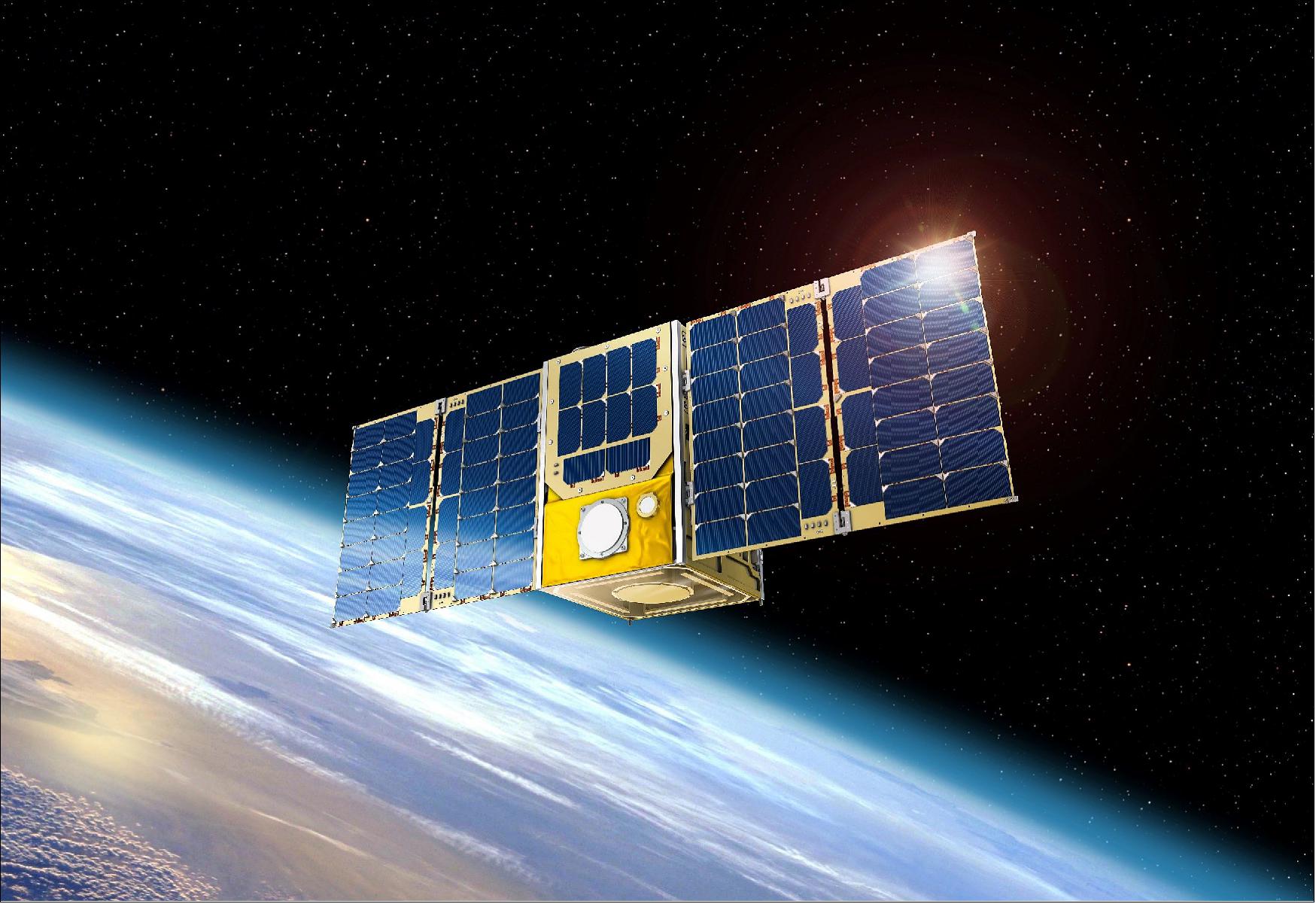
• January 13, 2020: The first test of the ARGOS NEO instrument on the ANGELS nanosatellite was a complete success. Messages from Argos beacons were picked up by the ARGOS NEO instrument and then transmitted to the L-band receiving station in Fairbanks, Alaska. 19)
- The beacon sending the first signals picked up by the instrument was on a Japanese fishing vessel off the coast of Australia. Thales Alenia Space supplied the ARGOS NEO instrument to French space agency CNES in partnership with the company SKYLINKS. These initial results confirm Thales Alenia Space’s expertise in The Internet of Things systems operating on very low power, a market segment pioneered in part by the Argos system.
- The French Space Agency, CNES, launched the first Argos nanosatellite, creating the beginning of a revolution in the Argos system. This nanosat is the prototype mission for Kinéis, a constellation of 25 nanosatellites with Argos instruments onboard that will be launched in 2022. This new constellation will receive data from around the globe with only 10-15 minutes between satellite passes, and is fully backward compatible with existing Argos beacons. It will also allow for more data transmission and two-way communication. This constellation represents a revolution in satellite telemetry. It will be the ultimate constellation for space IoT data collection and tracking, covering a wide-range of environmental applications.
• On 18 December 2019, Exolaunch received confirmation of the successful deployment of ANGELS (Argos NEO on a Generic Economical and Light Satellite) – the newest 12U satellite from French space agency, CNES. Designed by HEMERIA to gather important data about Earth’s environment, ANGELS was launched by Arianespace as part of the Soyuz-ST rideshare from the Spaceport in French Guiana. 20)

• July 25, 2019: Four tiger sharks have been tagged with a new device that will help conservationists to conduct detailed analysis of their migrations over years. 21)
- The device, developed in collaboration with ESA, uses the Argos satellite telemetry system but is smaller and more durable than existing Argos tags, as well as being cheaper and more animal friendly.
- It records pressure – indicating the depth of the shark – temperature, light level and tilt to enable three-dimensional mapping.
- The tiger sharks were tagged off the coast of Saba in the Dutch Caribbean, during an expedition organized by the Dutch Elasmobranch Society, the Saba Conservation Foundation and Nature Foundation Sint Maarten.
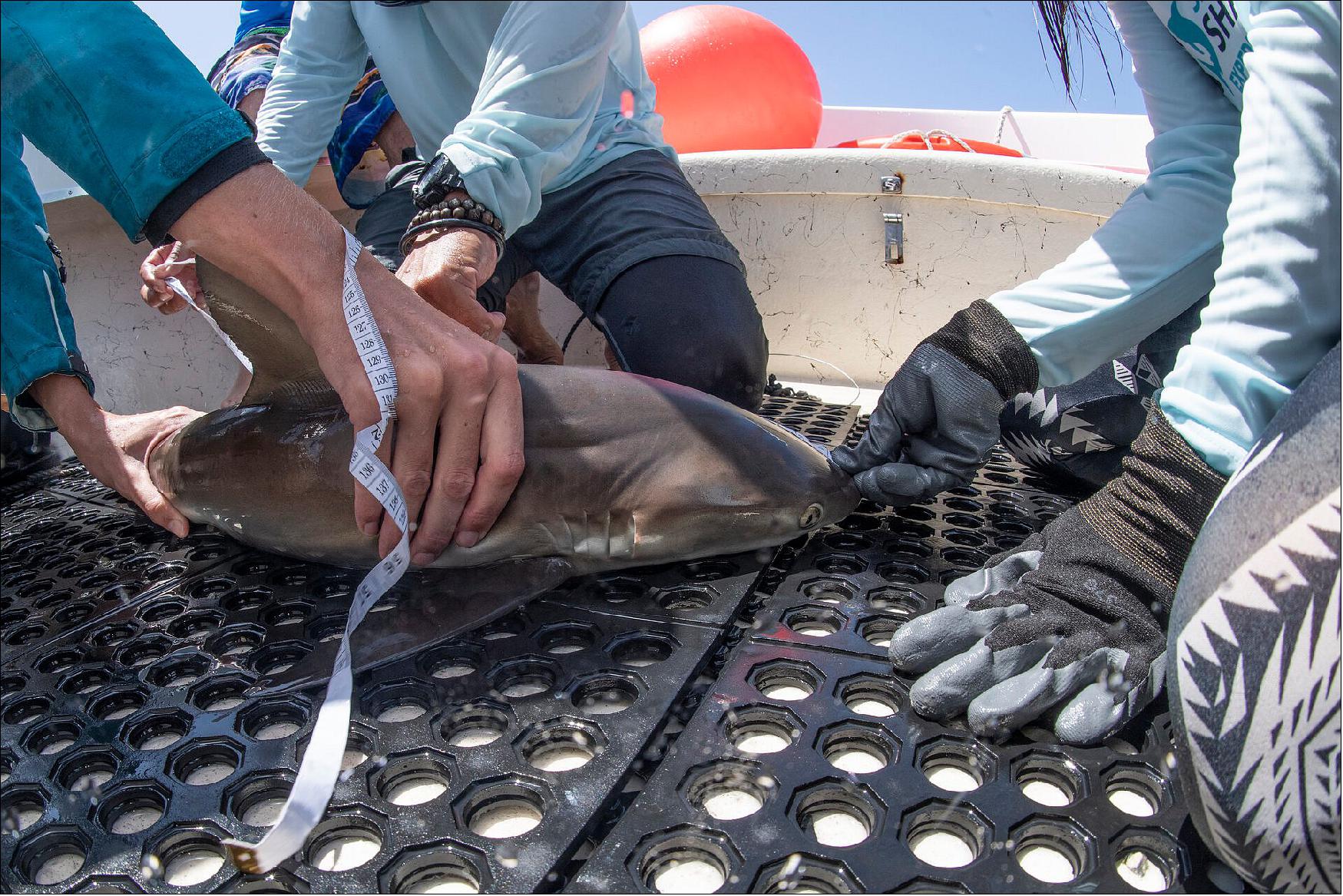
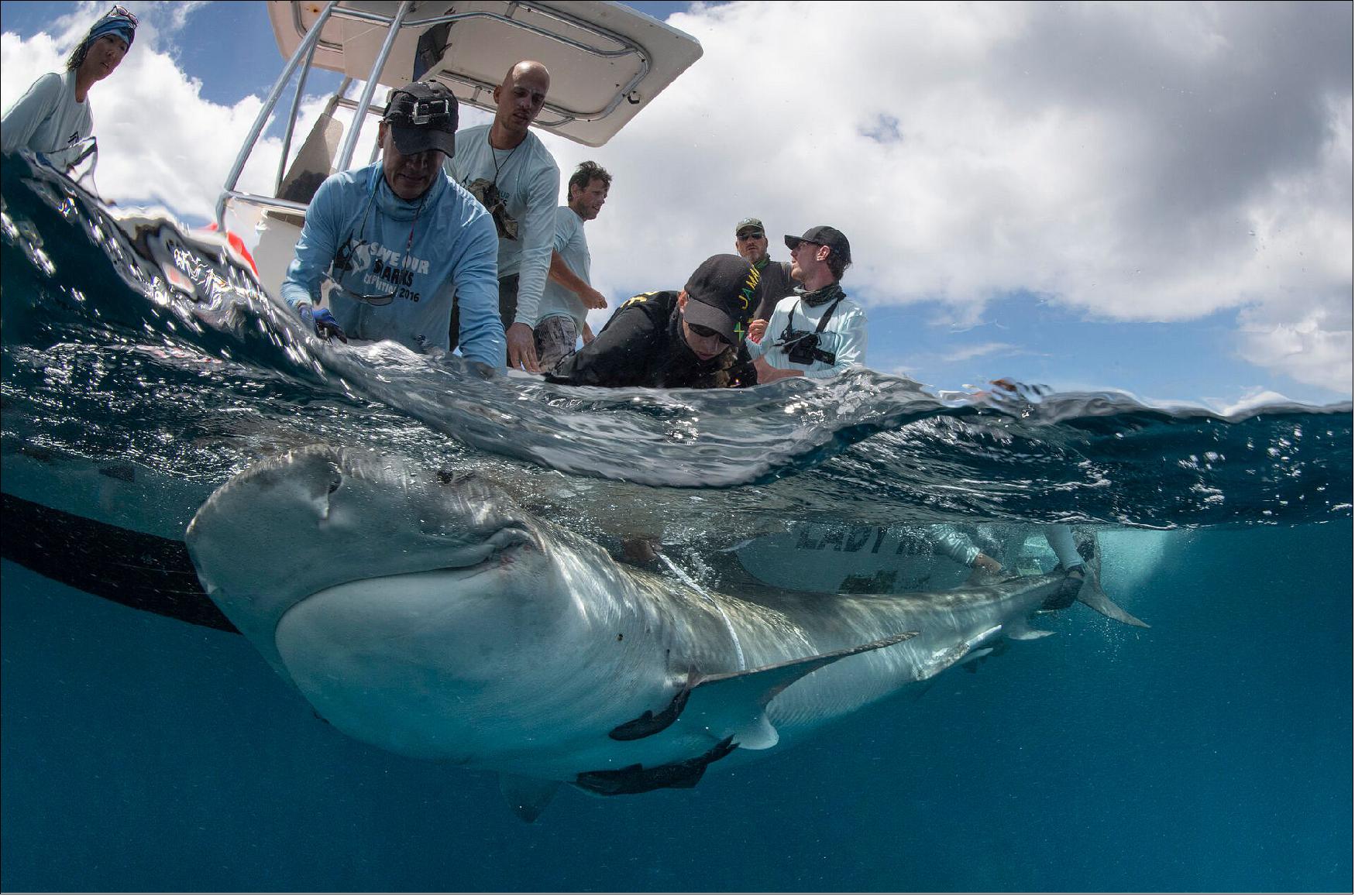
Sensor Complement
Argos Neo instrument
Argos Neo is a miniaturized data collection instrument, developed by Thales Alenia Space as prime in conjunction with Syrlinks, a manufacturer of radio-communications and geo-location equipment, as lead subcontractor (Ref. 2).
The objective of Argos Neo is to demonstrate the operational capability of a complex miniaturized instrument offering high performance on a smallsat platform. Argos instruments set the global standard in helping us understand climate change, improve weather and oceanic forecasts, protect flora and fauna, monitor our water resources, manage and protect marine ecosystems and track navigators during long-distance boat races.
The emergence of new satellite system requirements and the maturity of operational solutions based on nanosatellites and microsatellites is likely to change the satellite data collection landscape in the coming years. Thanks to the French space agency’s ambitions and support, the Argos system and its third and fourth generation of instruments have always been at the cutting edge of technology. They are now the civilian system with the world’s most powerful onboard software, capable of processing even very weak signals and providing unrivaled positioning accuracy, while also being the only system compatible with very small and energy-efficient beacons.
Over the years, these capabilities have made Argos the pioneer in spaceborne data collection systems, and more generally a pioneer in machine-to-machine systems that do not require any human intervention. Building on its role as the supplier of processors for Argos 3 and Argos 4 instruments, and this latest contract to develop Argos Neo, Thales Alenia Space is further cementing its role as a major European industry player in satellite data collection systems.
The miniaturized Argos Neo instrument on ANGELS will be ten times smaller than the previous-generation instrument and enable collection and location of low-power signals and messages from the 20,000 Argos transmitters currently operating around the globe. Given the instrument’s high sensitivity, which makes it prone to electromagnetic interference, special precautions have been taken and the design of the ANGELS satellite has been specifically adapted to the tight space available. Anechoic chamber testing of the satellite with a full engineering model representative of the flight model has validated these design choices while ensuring that messages from Argos transmitters will be correctly received without interference from other onboard hardware. The integrated CNES-NEXEYA project team and the Thales Alenia Space-Syrlinks-CNES ARGOS Neo project team pulled off this engineering challenge in barely 20 months, a very short time for a space project.
The payload is based on SDR (Software Design Radio) technology with use of Zynq 7030. The payload is made of a UHF receiver able to process Argos messages within 200 kHz of bandwidth in the 401-401.7 MHz frequency band. It’s clearly a new generation of ARGOS instrument in technological break with same functionalities and same level of performance as Argos-4 (receiving/processing part). There is no UHF downlink on this instrument, however it includes a L-Band transmitter able to download the mission telemetry generated by the instrument.
The miniaturized Argos NEO instrument has a volume of 20 x 10 x 6 cm , a mass of 1.5 kg and a power consumption of 15 W; it is capable of performing the same functions as an 18 kg system of past Argos missions!
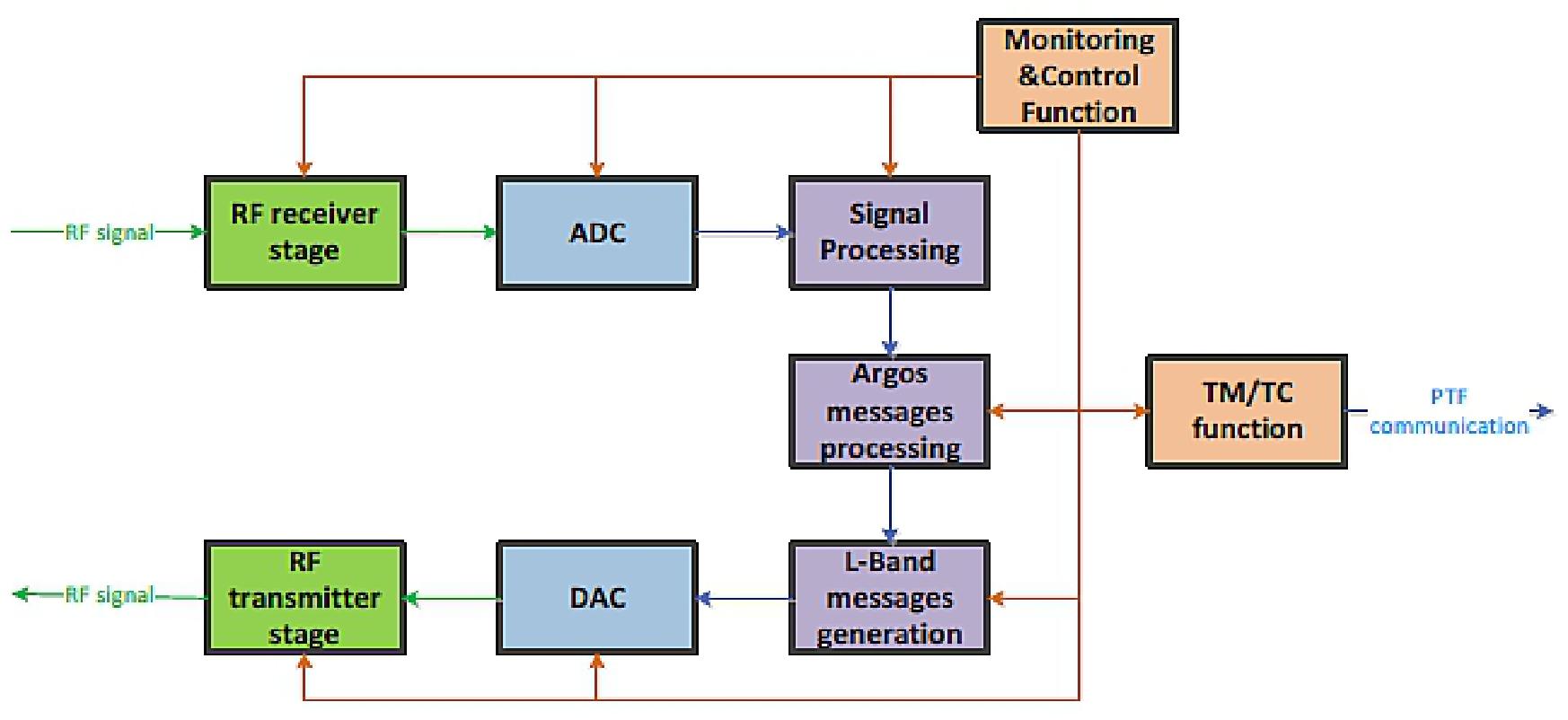
The antenna was designed by CNES and manufactured by Mecano ID, France. It’s a dual-feed collocated UHF and L-band antenna, based on a square array of tunable inverted F UHF antennas, and of one stacked circularly polarized L-band patch. Advanced miniaturization methods have been used to adapt the antenna for nanosatellite applications by limiting its footprint and volume, and it is installed in a cavity equal to half of a 4U standard volume (211 x 211 x 43 mm).
Instrument characteristics:
• Disruptive technologies and designing approaches, at hardware and software level
• Signal processing functionalities
• Demodulation of different waveforms, including high, medium & low bit rate
• Supervision by a Monitoring & Control Function to increase on-board autonomy
• New antenna L + UHF bands design to be fitted on a nanosatellite, without any deployment device
- L-band: circularly polarized dual-patch antenna
- UHF-band : array of four inverted F antennas with capacitive loading.
Ground Segment
The system is quite classical with
- a control ground segment using the CNES station network for the TMTC link
- and a mission ground segment using the CLS network for the mission TM reception in various sites around the Earth.
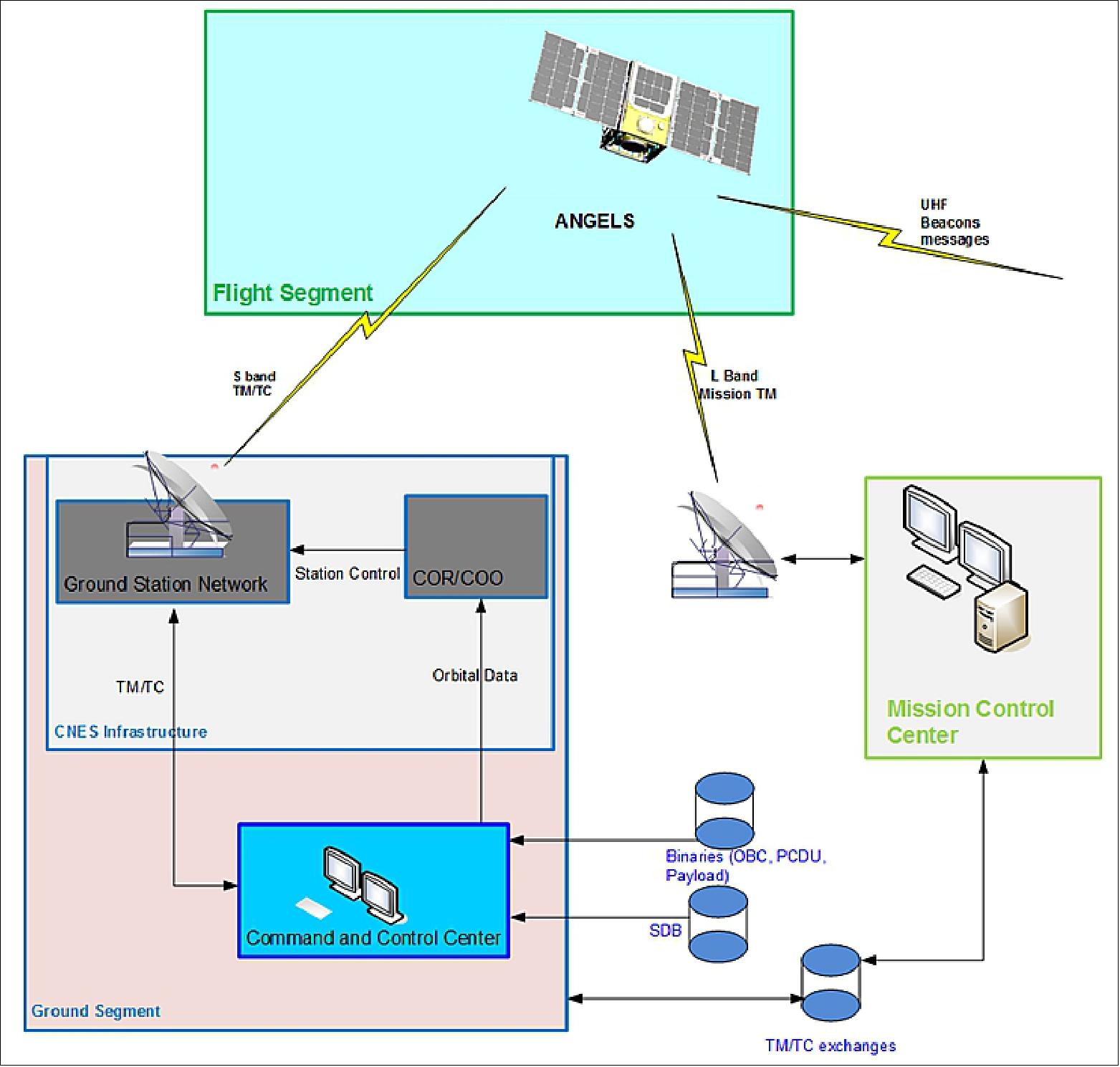
References
1) ”ARGOS ANGELS & NEO: CNES invests in a new nanosat Argos constellation,” ARGOS, 8 March 2017, URL: http://www.argos-system.org/argos-angels/
2) ”Thales Alenia Space to provide Argos Neo instrument for French space agency nano-satellite demonstrator, Angels,” Thales, 18 May 2017, URL: https://www.thalesgroup.com/en/worldwide
/space/press-release/thales-alenia-space-provide-argos-neo-instrument-french-space-agency
3) ”Smallsat Demonstrator Angels Will Carry Thales Alenia Space Argos Neo Instrument,” Satnews Daily, 19 May 2017, URL: http://www.satnews.com/story.php?number=648924365
4) ”ANGELS,” CNES, 27 March 2019, URL: https://angels.cnes.fr/en/angels-0
5) Information provided by Nicolas Multan, Director of Space Systems and Vice President of Nexeya.
6) C. Dudal, C. Laporte, T. Floriant, P. Lafabrie, ”CNES miniaturization policy: an answer to Nanosatelliteschallenges,” Proceedings of the 33rd Annual AIAA/USU Conference on Small Satellites, August 3-8, 2019, Logan, UT, USA, paper: SSC19-I-02, URL: https://digitalcommons.usu.edu/cgi/viewcontent.cgi?article=4563&context=smallsat
7) Information provided by Michel Sarthou, CNES Argos Project Manager
8) ”French Industrial Group Nexeya Spins Off Space Business Into New Company Hemeria,” Spacewatch, April 2019, URL: https://spacewatch.global/2019/04
/french-industrial-group-nexeya-spins-off-space-business-into-new-company-hemeria/
9) ”CNES and NEXEYA’S ANGELS nanosatellite on course for launch next year,” CNES /NEXEYA Press Release, PR203-2018, 13 December 2018, URL: https://presse.cnes.fr
/en/cnes-and-nexeyas-angels-nanosatellite-course-launch-next-year
10) ”KINEIS, a new key player in the New Space Race, is launching the first European constellation of nanosatellites. Global connectivity (IoT) is now at your fingertips,” CLS Press Release, 10 September 2018, URL: https://www.cls.fr/wp-content/uploads/Press-release-KINEIS.pdf
11) ”Thales Alenia Space to provide Argos Neo instrument for French space agency nano-satellite demonstrator, ANGELS,” Thales Group, 18 May 2018, URL: https://www.thalesgroup.com/en/worldwide
/space/press-release/thales-alenia-space-provide-argos-neo-instrument-french-space-agency
12) ”ARGOS ANGELS & NEO: CNES invests in a new nanosat Argos constellation,” ARGOS, March 8, 2017, URL: http://www.argos-system.org/argos-angels/
13) ”Syrlinks and Thales Alenia Space are developing the miniaturized Argos Neo payload,” Syrlinks, URL: https://www.syrlinks.com/en/the-1st-french-angels-nano-satellite-integrates-syrlinkss-equipments
14) ”Arianespace’s last mission of the year a complete success: COSMO-SkyMed Second Generation, CHEOPS, OPS-SAT, EyeSat and ANGELS now in orbit,” Arianespace, 18 December 2019, URL: https://www.arianespace.com/press-release/arianespaces-last-mission-of-the-year-a-complete-
success-cosmo-skymed-second-generation-cheops-ops-sat-eyesat-and-angels-now-in-orbit/
15) ”Arianespace Soyuz to Launch the CNES EyeSat Smallsat and to Deliver ANGELS to Space,” Satnews, 11 January 2019, URL: http://www.satnews.com/story.php?number=1165558904
16) ”Arianespace to launch ANGELS, the French industry’s first nanosatellite, in 2019,” Arianespace, 9 January, 2019, URL: http://www.arianespace.com/press-release
/arianespace-to-launch-angels-the-french-industrys-first-nanosatellite-in-2019/
17) Stephen Clark, ”Launch Schedule,” Spaceflight Now, 15 August 2018, URL: https://spaceflightnow.com/launch-schedule/
18) ”ANGELS, France's first industrial nanosatellite, extends the scope of space IoT,” CLS Press Release, 13 October 2020, URL: https://www.cls.fr/wp-content/uploads
/CLS-press-release-ANGELS-France-1st-industrial-nanosatellite.pdf?utm_source=sendinblue&
utm_campaign=CORPO_-_CP_Angels_oprationnel_EN_13102020&utm_medium=email
19) ”ANGELS Satellite's Successful Payload,” Satnews Daily, 13 January 2020, URL: http://www.satnews.com/story.php?number=845978691
20) ”Exolaunch Successfully Deploys ANGELS Nanosatellite, the First-ever European 12U CubeSat,” Exolaunch, 18 December 2019 [web source no longer available]
21) ”Caribbean reef shark being measured on deck,” ESA Applications, 25 July 2019, URL: https://www.esa.int/ESA_Multimedia/Images/2019/07/Caribbean_reef_shark_being_measured_on_deck
The information compiled and edited in this article was provided by Herbert J. Kramer from his documentation of: ”Observation of the Earth and Its Environment: Survey of Missions and Sensors” (Springer Verlag) as well as many other sources after the publication of the 4th edition in 2002. - Comments and corrections to this article are always welcome for further updates (eoportal@symbios.space).
Spacecraft Launch Mission Status Ground Segment References Back to top